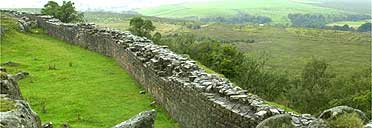
Once a terrifying reminder of Roman power, Hadrian's Wall still holds revelations about the people who built it, particularly for one Australian woman I met there.
'It's called Hadrian's Wall! Oh, I thought it was Adrian's,' she announced to thunderstruck silence. 'I thought it was a funny name for a Roman.'
The idea that a World Heritage Site could have been assembled by Adrian's army was easily the most unsettling experience of my recent hike along the length of the wall. The rest, I am pleased to say, was a delight, a pleasure that will very soon be shared by thousands of others following this week's opening of the country's newest national trail, the Hadrian's Wall Path.
What better excuse do you need to see one of the most dramatic sights the British countryside can provide its visitors? A line of tight, grey stones sweeps across hills and moorland with an utter disdain for landscape, a vision that still inspires awe almost two millennia after the wall's construction.
The path consists of 84 miles of rolling, northern terrain - three miles more than originally planned, an increase forced by landowners and archaeologists who demanded constant detours and bypasses. The end result is a compromise between heritage and amenity, admits David McGlade, its development officer. 'It mostly follows the wall but occasionally diverts from it. There is no pleasure walking through city traffic, after all. So the first five miles - from Wallsend to Tyne Bridge - take you west by the river.'
Running along old rail track, the path here is still surprisingly rural, with banks of wild flowers and views of wading redshanks. Great fun, but little to do with our Roman past. For that you must stride 10 more miles, along the B6528 to Heddon before you find the first proper chunk of wall, a line of Roman bricks running outside the village.
Make the most of it for after Heddon there is still little to titillate the historical enthusiast, with the trail running parallel to the B6318, a fairly uninspiring stretch of path that nonetheless absorbed most of the path's total £6 million budget in order to turn a hodge-podge of local rights of way into one track.
Persevere, for you are approaching the path's most dramatic section. At Housesteads, the Romans built a mighty fort and then ran the wall west over sheer crags that soar out of the moor. This is bleak, magnificent terrain that the Romans exploited adroitly. Stand here - on the only bit of wall on which walking is permitted - and you can imagine legionnaires pining for their Tuscan vineyards as they peered north, awaiting onslaught from Picts bent on swarming the wall like Saruman's hordes at Helm's Deep.
In fact, there is no evidence anyone ever tried to breach the wall which was never really built for defence. When faced with troublesome tribes, Rome's legions simply marched out and gave them a good smacking in open combat. This was no Berlin Wall for the second century, but a blockade through which Romans could control trade. Nor was it manned by soldiers from Rome. Its garrisons came from Tungria (in Belgium and Holland) and Gaul - though it is still unlikely they found the posting much fun, as W.H. Auden noted in his 'Roman Wall Blues':
The rain comes pattering out of the sky,
I'm a Wall soldier, I don't know why.
The mist creeps over the hard grey stone,
My girl's in Tungria, I sleep alone.
From Housesteads, the wall undulates over rolling dales - the path's most tiring terrain. So plan your accommodation ahead and pick B&Bs that will take your packs on to your next night's rooms. Most will. Freed of the weight on your back, you will find a real spring in your step. (Another tip: walking east to west, into the wind, was probably a mistake, I discovered.) The path finally drops to Greenheads' Roman Army Museum where they show films of aerial tours and virtual reconstructions of the wall - well worth a stop. After that, walk on to Thirwall Castle and you are now in the path's finest section. The trail descends gently through lush fields to Gilsland and on to Birdoswald fort and Banks.
Most walkers will entertain no deviations from the main route, of course - which is a shame, for the path's creators have designed dozens of linked walks that are often more attractive than the main path's more prosaic sections. So take a final tip: don't be a purist, deviate. For example, at Banks, there is a detour south, past Lanercost Priory, and down through Quarry Beck - one of the finest woodland walks I have come across. You stroll down to Brampton and then rejoin the main path at Newtown. And that is the real value of the Hadrian Wall Path, not that it links Bowness to Wallsend, but that it provides superb support : alternative walks, bus connections, helpful landladies, and historical sites.
Back on the path, the final route to Carlisle leaves the wall's course again and takes you past the uninspiring banks of the Eden and into Carlisle. Fanatics can walk to Bowness. I took my blisters back to London by train.
Factfile
Robin McKie stayed at the Saughey Rigg Farm (01434 344120) at Bardon Mill, in the middle of the Hadrian's Wall footpath, for £15 B&B, and at Kirby Moor Hotel (016977 3893) in Brampton near Carlisle, which costs £37pp B&B based on two sharing.
Hadrian's Wall Buses run daily from 24 May to 14 September via most key wall sites. Details from Hadrian's Wall Tourism Partnership (01434 322002).
GNER (08457 225225) has one-way tickets from London to Newcastle from £24 or returns from £33 booked a week in advance. Virgin Trains (08457 222333) has one-way tickets from Carlisle to London from £15.50 and returns from London to Carlisle from £31 booked two weeks in advance.

